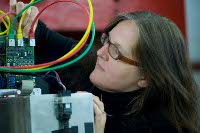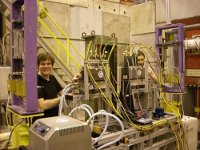 |
 |
|||||||||||||
|
|||||||||||||
|
|||||||||||||
|
Ingrid Gregor and her team will have a very busy summer. As a particle physicist, she coordinates a successful device for test beam infrastructures, the EUDET telescope, which is fully booked at CERN during the next four months. In her rare spare time, she also experiences the joys of blogging as she just joined the team of the ILC Quantum Diarists.
A telescope is a tool needed to test high-resolution particle detectors. Within EUDET, an EU-funded infrastructure programme for ILC detector R&D, Ingrid Gregor, DESY physicist, coordinates a team of scientists from Germany, Italy, France, Poland, UK and Switzerland, who designed and constructed a challenging high-precision telescope. Its six boards, fitted with silicon pixel sensors, can measure the beam particle tracks to a precision of three micrometres, while another device, typically pixel or strip detectors, can be positioned in the middle to be studied. One of its most interesting features – besides its high resolution – is its flexibility. “Our telescope is a real modular device,” says Gregor. Its key element, called the "Trigger Logic Unit", makes it possible to send trigger signals to any particle detector with only few adaptations. This nearly plug-and-play telescope is much appreciated by the particle detector community. “Usually, beam telescopes are specifically designed for a given project, and it's often rather difficult to use them for other purposes,” says Gregor. “Adapting logics, software and electronics could sometimes take up to months.” The EUDET telescope team provides the device to users, along with trigger hardware, readout computer, data acquisition and analysis software. “In principle, with our telescope, one can start taking data in only a few days,” says Gregor. “The problem is that many users simply neglect to read our manual before coming, hence loosing a lot of precious test beam time.” Is this the price of fame? “Some users might overestimate our device's flexibility!” concludes Gregor. (The users' page can be found here) Fully commissioned in summer 2007, the telescope is now at CERN for a third summer, while it is used at the DESY test beam during the rest of the year. Already in 2008, several users had the opportunity to book and test their detectors thanks to it. This summer is now totally full with ten users coming from the particle physics community at large: ILC, LHC but also sLHC, a planned LHC upgrade. Gregor is, of course, delighted that her team's device is now used and successful... even if it means lots of maintenance during the test-beam period. Three physicists from Switzerland and Germany are staying at CERN to help. As a coordinator, Gregor expects to be called upon very often. There are always little things to take care of: users needing advice how to turn the telescope back on after a power-cut... “But I'm not alone, and I have a lot of help from my great team,” says Gregor. Next November the telescope will go back to DESY, where it will be part of the 6-GeV electron beam infrastructure. Ingrid Gregor was not bound to be a particle physicist from the beginning. She studied physics engineering but was not fond of the jobs that were proposed to her. During this period in her life, she visited CERN for the first time. When she went down one of the LEP caverns (Large Electron-Positron Collider – the predecessor of the Large Hadron Collider), she knew at once that she wanted to become a "real physicist". At that time she was part of one of LEP's four experiments called DELPHI, working on the first larger pixel detectors in high-energy physics: the Very Forward Tracker. Always based at Wuppertal University, Germany, she took her PhD on the LHC's ATLAS experiment. She then moved to DESY and worked at the HERA accelerator as a member of the HERMES and then the ZEUS collaborations. She's now working on both ILC and LHC projects. The EUDET Telescope was one of the first subjects covered by Ingrid in her Quantum Diaries' blog. “I was a bit nervous at first, wondering if I would find topics to write about each week.” So far she's has been rather productive though. “In fact, I find myself thinking of new posts more and more often, especially when I'm relaxing during weekends”. Ingrid also gave herself a challenge while writing her posts' titles: “I'm not sure that I will be able to quote a song or movie title each time, but it's at least fun to give it a try,” she smiles. As a conclusion of her bio on Quantum Diaries, Ingrid ends: “Besides all the work, I still have a life. I like to travel, especially to the south of Brazil, spending time with friends and family. If I'm not travelling, I like to read adventure books or criminal stories.” No Shadow of Doubt this enthusiastic scientist will always finds topics to write about. -- Perrine Royole-Degieux
Links: |
|||||||||||||
| © International Linear Collider |

